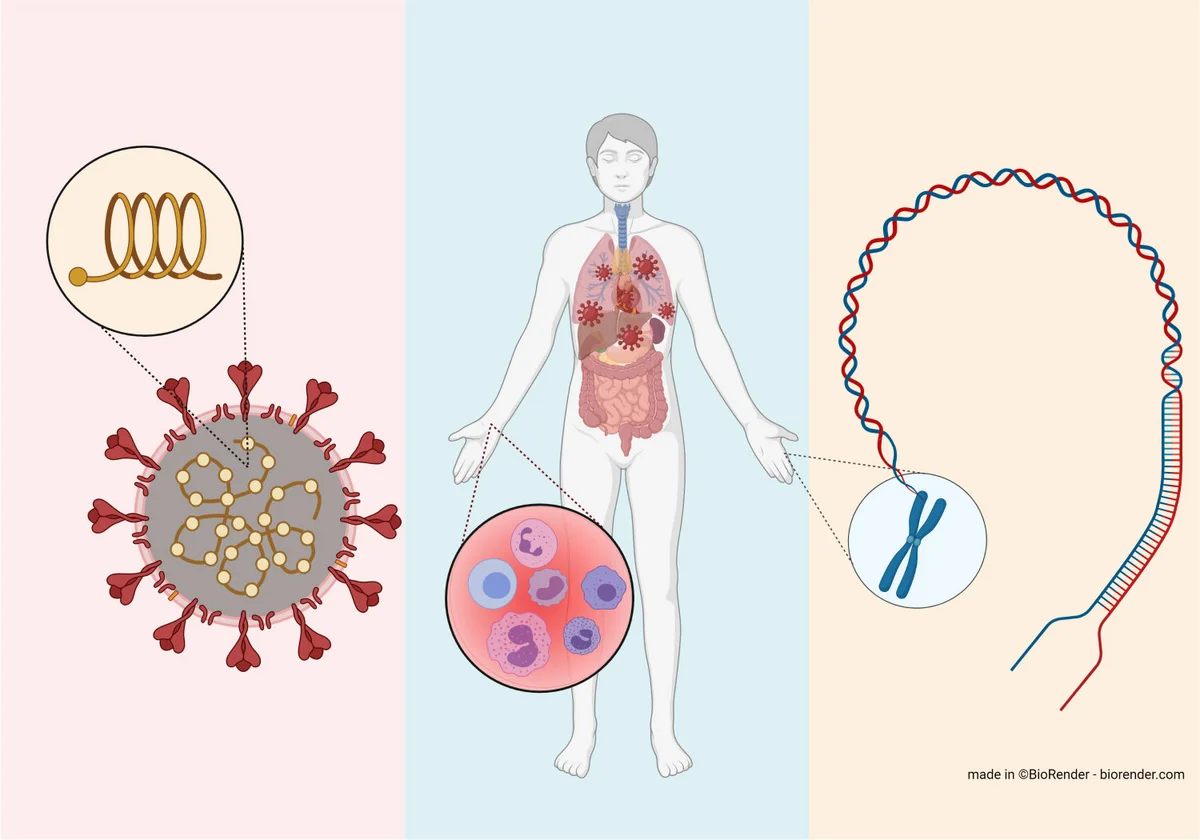During the COVID-19 pandemic, German research groups were among the most active contributors to research about various topics related to the pandemic. To centralise data storage and further establish a culture of data sharing, CoFGen, the German data collection for functional genomics in COVID-19., was launched.
It was developed by a team of reseachers located at the German Center for Neurodegenerative Diseases (DZNE) in Bonn and the LIMES Institue of Bonn University, in collaboration with GHGA, the German COVID-19 Initiative (DeCOI), the Lung Biological Network of the Human Cell Atlas (HCA) and FASTGenomics (FG).
The aim of CoFGen is to collect single-cell and bulk RNA-sequencing datasets and analyses from German research groups and make them easily available to other researchers while complying with FAIR principles and ensuring GDPR-conformity. At the same time,research on COVID-19's influence on the human immune system will be advanced..

Functional genomics studies the interplay of genes, signaling pathways and gene products. For this, transcriptomes, the entirety of RNA molecules that are expressed in cells or tissues at a certain point of time, are sequenced and analysed. Thus, we can monitor which gene sequences are transcribed at a certain point in time or in health and disease.
CoFGen focususes on transcriptome data that was collected to study the immune response to a SARS-CoV-2 infection. During the pandemic, many new insights were gained into the role of different immune cells in the response to SARS-CoV-2.
To make both data and results comprehensible, CoFGen not only collects single-cell and bulk-RNA-sequencing datasets but also analysis workflows and stores them together with the respective data. In accordance with the FAIR data principles, CoFGen facilitates sharing of data between researchers who focus on different aspects of the immune response to SARS-CoV-2 and COVID-19 and thus advance research in these fields.
Philip Rosenstiel, Institute of Clinical Molecular Biology, Kiel University and University Medical Center Schleswig-Holstein, 24105 Kiel, Germany
Thomas Ulas, Systems Medicine, German Center for Neurodegenerative Diseases (DZNE), Bonn, Germany / PRECISE Platform for Single Cell Genomics and Epigenomics at the German Center for Neurodegenerative Diseases and the University of Bonn, Bonn, Germany
Birgit Sawitzki, Institute of Medical Immunology, Charité – Universitätsmedizin Berlin, Berlin, Germany
Jacob Nattermann, Department of Internal Medicine I, University Hospital Bonn, Bonn, Germany / German Center for Infection Research (DZIF), Germany
Yogesh Singh, Institute of Medical Genetics and Applied Genomics, University of Tübingen, Calwerstrasse 7, 72076, Tübingen, Germany / NGS Competence Center Tübingen (NCCT), University of Tübingen, Calwerstrasse 7, 72076 Tübingen, Germany / Research Institute of Women’s Health, University of Tübingen, Calwerstrasse 7/6, 72076, Tübingen, Germany
Olaf Riess, Institute of Medical Genetics and Applied Genomics, University of Tübingen, Calwerstrasse 7, 72076, Tübingen, Germany / NGS Competence Center Tübingen (NCCT), University of Tübingen, Calwerstrasse 7, 72076 Tübingen, Germany
Antoine-Emmanuel Saliba, Helmholtz Institute for RNA-based Infection Research (HIRI), Helmholtz-Center for Infection Research (HZI), Würzburg, Germany
Leif Erik Sander, Charité - Universitätsmedizin Berlin, Department of Infectious Diseases and Respiratory Medicine, Charité, Universitätsmedizin Berlin, Berlin, Germany/ German Center for Lung Research (DZL), Germany
Alex K. Shalek, Program in Health Sciences & Technology, Harvard Medical School & Massachusetts Institute of Technology, Boston, MA 02115, USA / Institute for Medical Engineering & Science, Massachusetts Institute of Technology, Cambridge, MA 02139, USA / Koch Institute for Integrative Cancer Research, Massachusetts Institute of Technology, Cambridge, MA 02139, USA / Ragon Institute of MGH, MIT, and Harvard, Cambridge, MA 02139, USA / Broad Institute of MIT and Harvard, Cambridge, MA 02142, USA / Harvard Graduate Program in Biophysics, Harvard University, Cambridge, MA 02138, USA / Department of Chemistry, Massachusetts Institute of Technology, Cambridge, MA 02139, USA / Program in Computational & Systems Biology, Massachusetts Institute of Technology, Cambridge, MA 02139, USA / Program in Immunology, Harvard Medical School, Boston, MA 02115, USA / Harvard Medical School, Boston, MA 02115, USA / Harvard Stem Cell Institute, Cambridge, MA 02138, USA
Jose Ordovas-Montanes, Broad Institute of MIT and Harvard, Cambridge, MA 02142, USA / Program in Immunology, Harvard Medical School, Boston, MA 02115, USA / Division of Gastroenterology, Hepatology, and Nutrition, Boston Children’s Hospital, Boston, MA 02115, USA / Harvard Stem Cell Institute, Cambridge, MA 02138, USA
Patrick T. Ellinor, The Broad Institute of MIT and Harvard, 75 Ames Street, Cambridge, MA 02142
Nicholas E. Banovich, Translational Genomics Research Institute, Phoenix, AZ, USA
Christoph MuusView, Klarman Cell Observatory, Broad Institute of MIT and Harvard, Cambridge, MA, USA / John A. Paulson School of Engineering and Applied Sciences, Harvard University, Cambridge, MA, USA
Malte D. Luecken, Institute of Computational Biology, Helmholtz Zentrum München, Neuherberg, Germany
Waradon Sungnak, Wellcome Sanger Institute, Cambridge, UK